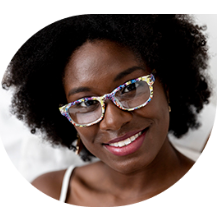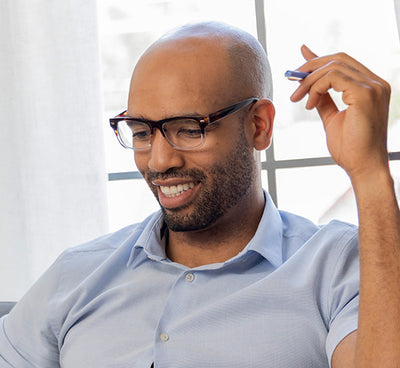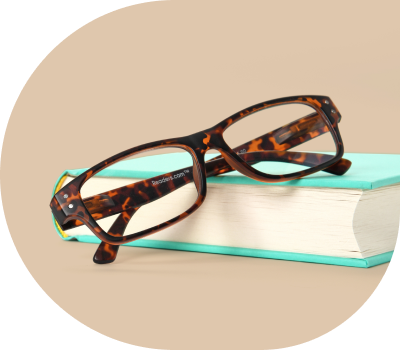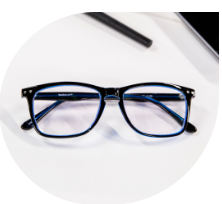Article reviewed by Dr. Holly J. Vaught, OD
Sometime after the age of 40, you may notice that your vision isn’t what it used to be, but you can still see relatively well. Then one day, the menus at restaurants are a bit blurry and you find yourself squinting. Your eyes feel strained at the end of the day, and you find yourself holding your phone out at arm’s length to read your text messages. Does this sound like you?
These are some of the most common signs and symptoms that you may be developing presbyopia, the clinical term for what happens to your eyes as you age, creating the need for reading glasses.
Between the ages of 40 and 65, most people’s eyes go through a change that leads to presbyopia. The eye’s lens, which contracts and expands thanks to the help of a circular muscle, becomes less flexible and more rigid over time. This hardening of the lens prohibits the eye from contracting to focus on close-up objects, which is what causes fuzzy vision when trying to read.
Although this may sound frightening, everyone develops some degree of presbyopia during their life. In fact, more than 120 million Americans need vision correction for presbyopia. Luckily, there are several easy fixes to correct your reading vision! The most common solution is wearing a pair of reading glasses, also referred to as “readers.”
If you’re going to be buying and wearing reading glasses for the first time, you’ll find the words “reading power,” “reading strength,” “reading magnification,” and “diopter” used interchangeably – they all mean the same thing.
When it comes to reading powers, the lower the number, the less magnification there is in the lens. At Readers.com®, we carry powers from +1.00 to +3.75, including quarter powers (+.25 increments) and half powers (+.50 increments) so you can get the reading power you need.
There are several ways to determine which reading power is right for you:
At your annual eye exam, ask your eye doctor what reading power you need.
If you have a current reading glasses prescription with the “ADD” power listed, use our Power Finder Tool to determine the best reading power for you. You can also use this tool if:
- You have a pair of readers that used to work for you, but now things are a bit blurry again and you believe you need stronger power.
- Or to get an estimated reading power based on your age range.
This printable chart can be used as a guideline to determine the best reading power for you. If you can see two lines equally clearly, choose the lower power. The chart goes up to a +3.25 power, so if your vision requires a stronger power, we recommend visiting an eye doctor to find your reading power.
Visit our What Reading Glasses Power Do I Need? guide to learn more.
Beginning your search for a pair of reading glasses may seem daunting, but if you know the answers to the following questions, you’ll be able to find the perfect pair of readers in no time!
Bifocal readers have unmagnified lenses which also contain inserts with the magnification of your choice in the lower portion of the lenses. This lens type is perfect for those who prefer to wear their readers all day, or who look from their reading to distance vision frequently.
Fully magnified reading glasses have the magnification of your choice throughout the entire lens. This lens type works best for those who only want to wear readers when necessary.
Computer readers are the best option for those using a computer or other digital device for a long time. Available in fully magnified, multifocal, or unmagnified lenses, special lens coatings, and tints help reduce eye strain.
Headed outside? Our reading sunglasses are available with bifocal style or fully magnified lenses and will help you see clearly while protecting your eyes from the sun’s UVA-UVB rays.
Knowing your personal style and the frame shape that looks best on you will help you choose the perfect pair of readers! From classic frame colors to playful patterns, very narrow to very wide widths, and any frame shape imaginable, reading glasses aren’t the one-size-fits-all glasses they used to be.
Here’s a printable ruler to help you find a style in a size that will fit you best!
Many people will debate over the best place to buy reading glasses, and it honestly comes down to what you’re looking for in a pair of reading glasses. Over the counter, non-prescription reading glasses are commonly found at drug stores, discount stores, and other retailers, but did you know that you can purchase reading glasses online?
If you have all the info mentioned in this guide, you’re set to start shopping! Readers.com® is one of the largest online reading glasses retailers, with more than 500 unique styles! We understand it can be a little harder to buy reading glasses online, which is why we offer a simple 90-day return or exchange policy.
SOURCES
- Presbyopia: Symptoms, Causes & Treatment. Cleveland Clinic. July 2023.
- U.S. Reading Glasses Market Size & Growth Report [2030]. Fortune Business Insights. October 2024.
- Bifocal Glasses - Lenses Great for Reading. Eyebuydirect. May 2022.
The sources listed here have been provided for informational purposes only. The citation of a particular source does not constitute an endorsement or approval of EssilorLuxottica products, services, or opinions by such source.
*Like Readers.com, Eyebuydirect is an affiliate of EssilorLuxottica.
Dr. Holly J. Vaught, is the eye doctor at Vaught Family Eye Care in Franklin, Indiana, where she provides comprehensive services for patients of all ages. In 2009, she graduated with honors from Indiana University School of Optometry. Her training includes the areas of diagnosis and treatment of common ocular diseases, primary care, contact lenses, and pre- and post-op care for refractive and cataract surgeries. Dr. Vaught is a member in good standing of the American Optometric Association, the Indiana Optometric Association, and Women of Vision.
Disclaimer: All references to “bifocals” or “bifocal readers” herein refer to readers having unmagnified lenses containing a “bifocal style” single-powered reading glass insert located in the lower portion of the lenses.
















